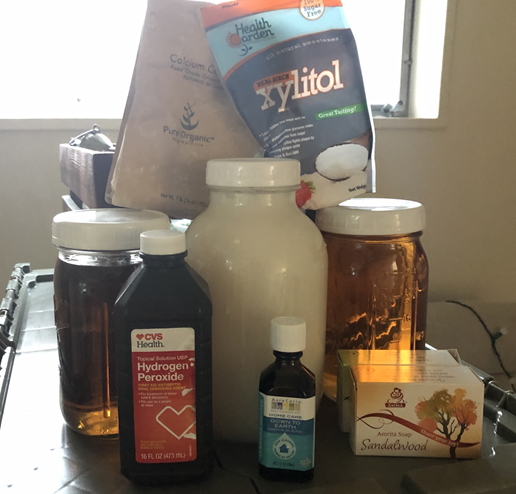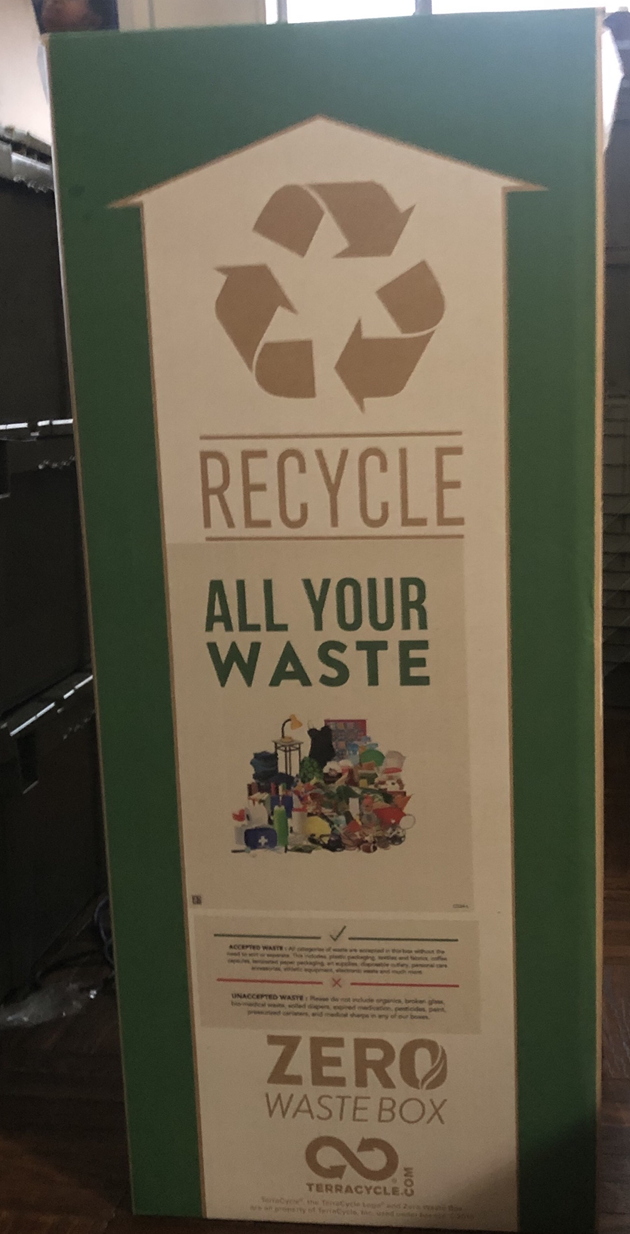
| Home | Source Reduction | Friends of Green Friends | Newsletters |
| Gardening | Resources | What You Can Do | Embracing The Trees |
| Going Zero Waste - Strategies to Reduce and Recycle Packaging | |
 A couple of supplies we have on hand. The smaller jars contain castile soap, which I use as a key ingredient in laundry detergent. I also mix castille soap with essential oils for household cleaning; some essential oils have antibacterial properties. |
As things heat up in the world and Mother Nature seeks to heal herself by keeping us indoors, Amma says it is important to learn how to live in harmony with nature. One thing we can do is re-read the Indeed Pledges and spread them. Another thing we can do is try to reduce our carbon and usage footprints by trying to go as Zero Waste as possible. The more we can keep out of landfills and air, the less we produce, and the more eco-friendly and non-toxic our production systems, the better. In this article, we will present ways to go Zero Waste, even given the current pandemic, with strategies to reduce and recycle packaging.
Make Your Own There are recipes for laundry detergent, tooth powder, deodorant, dish soap, lip balm, shampoo and shower gel on the internet. Although the ingredients for some of these do come in plastic, you can still cut down on waste by making them yourself and making a pledge to recycle the packaging. So far, I have found laundry detergent and tooth powder recipes that work for me. For sensitive skin, limit the amount of baking soda in any homemade deodorant. I also personally do not like working with beeswax as it tends to become rather tough and stick to my pans. It may take a few tries to find recipes and methods you like, but eventually, it will happen. |
| Personally, I prefer simple recipes and approaches. For lip balm and moisturizer, rather than getting fancy with recipes, I just use plain cocoa or shea butter. You can find sellers who will sell these products in paper packaging - or if you buy in plastic bulk and reuse/recycle the plastic, you will still be limiting your waste.
You can also look for ways to make your own versions of commonly packaged food items to cut down on waste - look for simple blender-based, ice cream recipes, use a spiralizer to make veggie pasta, etc. Try to use electronics you already have and/or use durable tools (i.e. a manual spiralizer that you can resharpen) for these recipes so as to prevent e-waste and unnecessary accumulation of gadgets. Boxes and Bulk Instead of Plastic Packaging Rather than making your own, you can always pledge to try and use paper or recyclable packing instead of plastic packaging as much as possible . There are deodorant bars, shampoo bars and soap bars you can buy online. They seem more expensive, but they tend to last longer. For dish soap, try to buy in bulk or find a supplier who allows you to refill dish soap at their stores using your own container. For toothpaste, switch to tooth powder that comes in a metal tin. On a related note, for when we are eating out again, bring reusable containers to carry food out from restaurants – whether takeout or leftovers. Most restaurants will oblige. You can find "collapsible" lunch boxes online that are handy and easy to store to use in a pinch. Or, try to only eat at restaurants that use real dishes and/or compostable containers. I categorically do not buy from restaurants that will not let me use my own boxes or do not offer takeout containers that are mostly compostable. I always refuse the cutlery - if it’s a delivery order, sometimes you need to call the restaurant to request no cutlery or napkins and paper instead of plastic bags. If the restaurant uses plastic cutlery for sit-down meals, consider bringing your own utensils. Finally, buying in bulk at grocery stores with bulk sections can save on plastic use if they allow refillable containers. At some grocery stores, you can bring your own containers (be sure to weigh them before filling, so the cashier can adjust the item price). This may not be an option at many grocery stores during the pandemic. |
| Request Paper Bags at Grocery Stores
Related to grocery shopping, make sure you limit the amount of waste you generate going to the grocery store. If I am getting groceries delivered or buying groceries myself, I specifically request paper bags or boxes to carry out my groceries in. We used to be able to take reusable bags to the grocery store, but this does not seem to be allowed these days. If you are ordering grocery delivery, be sure to ask your shopper to request paper bags/cartons instead of plastic. Most will be happy to oblige, and you may be able to influence them positively, too! Combine Shipments, Reuse Packaging I try never to buy items in a piecemeal fashion from online companies. I try to thoughtfully fill my online cart before I hit “purchase” so companies can combine all my shipments. You may also be able to request that the company in general combine your shipments and use paper packaging. It just takes an email or a few minutes of time on live chat. It may not always work, but it is worth a try. If a company cannot combine shipments or reduce waste, I try my best not to order from them. Another related strategy is to strive to buy only “in stock” items from local stores for pick up and request no/little packaging. This could be a way to both support local jobs as well as reduce one’s online shopping packaging footprint. |
|
 A 'Zero Waste box in my home. I use it to recycle plastic packaging, chip bags, candy wrappers, plastic forks, waxed paper containers like ice cream boxes, etc., if I end up using them and/or have been able to collect them to recycle from various places. |
Look for Ways to Recycle Non-recyclable Waste When all else fails and we have to use non-recyclable items packaging (i.e., chip bags, candy bar wrappers, saran wrap) that we need to throw away, we can look for companies that offer “Zero Waste” services. There is at least one global company named Terracycle that accepts non-traditionally recyclable waste via mail if you buy a "Zero Waste box" or if one of their free recycling programs meets your needs. You can look them up online. It can be expensive to go this route, though, so definitely focus on reducing first. For larger items like solar panels, mattresses, household electronics and styrofoam blocks, do some online research. You may be able to find local or online companies who will recycle these items for a fee, for free, or even pay you to recycle them. It may take some money and effort to find non-traditional recycling routes. But if we don’t spend time and effort on our environment, thinking of where our waste goes, and taking care of Mother Nature, we or our children risk possibly not being able to live on Earth any more in 40 years. This is a scary proposition that having money will not fix. Remember to Re-Use Finally, although this article does not focus on reusing, do keep this as a strategy in your toolkit as well. Many products that cannot be recycled can be upcycled into something new. It's worth looking into, to see if someone has already thought of a way to upcycle that item or tuning into your own creativity to see if you can find a way to give that product new life before it meets the landfill. Reduce before reuse, reuse before recycle, and recycle before landfill, if no other choice, in this order. As Amma quoted in one of her Satsangs recently, there is a Native American saying that "Only when the last tree has been cut down, the last fish been caught, and the last stream poisoned, will we realize we cannot eat money." Let us not learn the hard way. Let us spend what is reasonable and within our means to ensure that we and the global family have an Earth to live on, else no amount of money can save us. |
| Diksha - Bethesda, MD
Disclaimer Any reference in this website to a specific product, process, or service does not constitute or imply an endorsement by GreenFriends North America or MA Center. |
|
Read Lessons I Learned From Gardening from the Summer 2020 newsletter >>
| Home | Source Reduction | Friends of Green Friends | Newsletters | Resources | What You Can Do | Contact Us |
For more information, e-mail info@greenfriendsna.org |
||||||